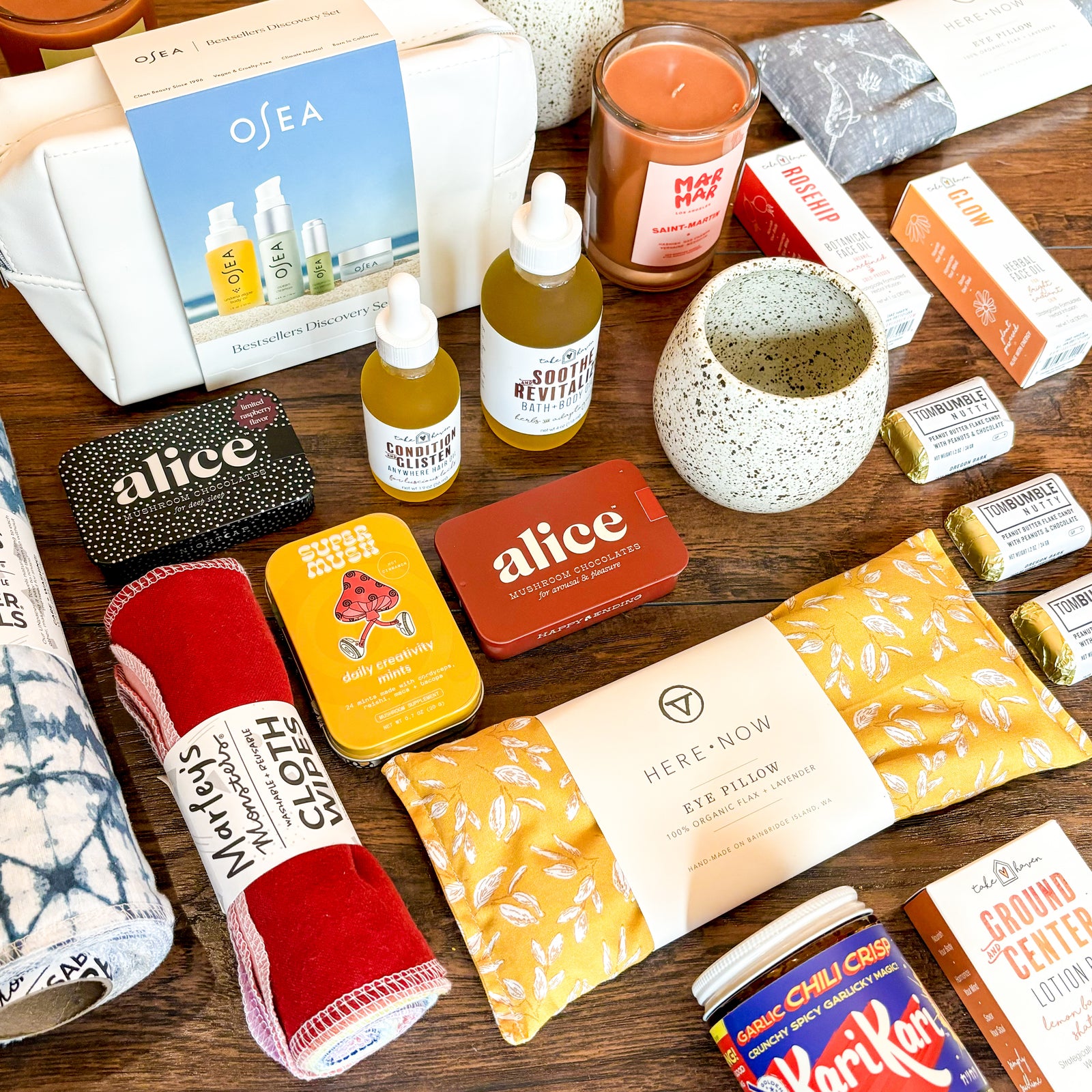BEAUTY QLEAN! - BY SOPHIE KNAPP, MScN, CN

Self care is priority, and our rituals around skin and hair care can serve as opportunities to make time for that necessary TLC. Being a WILLOWTREE lover, you likely seek out products that tenderly nourish your well-loved soma and are crafted with intention to omit chemicals that be harmful to your health. You may say that for you to feel like a ‘beauty queen,’ your beauty needs to be ‘qlean!’
But what does ‘clean’ really mean?
Marketers are experts at using buzzwords to suck us into buying their products, but every buzzword is not created equal. Phrases like ‘organic,’ ‘vegan,’ and ‘gluten free’ are found all over all types of products and require oversight, validation, and certification from governing bodies to be legally written on a product or used to market it. Since unbiased third parties are double-checking, when you see those words on a label, you know that they truthfully describe the product.
Other terms like ‘eco-conscious,’ ‘natural,’ and ‘clean’ aren’t subject to the same regulation, and the collection of terms that sound legit but don’t hold water like these are out there in profound abundance. Lack of oversight for terms like these leaves the door wide open for often misleading and empty phrases like ‘clean beauty’ to get thrown around willy nilly.
If you hear or see ‘clean’ used to describe a product, unfortunately, you can’t take it at face value.
Luckily for our community, WILLOWTREE has vetted every beauty product in our store to ensure that they fit our rigorous requirements to be deemed squeaky clean and as safe as possible for you to use in direct contact with your cherished temple each day.
We refuse to sell products containing harmful ingredients because their use has been linked to health issues like endocrine disruption and cancer. It’s a wonder why these ingredients haven’t been banned by a governing body like the FDA because many other places like the European Union and our own state of California outlawed most of them a while ago.
When WILLOWTREE says clean, this is what we mean:
Our products are completely free from the most harmful ingredients frequently used in the beauty industry including but not limited to:
- Phthalates
- Parabens
- Formaldehyde
- PFAS
- Synthetic fragrances
Let’s dig into why we avoid these ingredients:
Phthalates:
These chemicals often have long names that get abbreviated, even on labels: di(2-ethylhexl)phthalate is DEHP, dibutyl phthalate is DBP, diethyl phthalate is DEP, and butylbenzyl phthalate is referred to as BBP. Phthalates often used to make plastics more flexible and durable, and according to the FDA’s website, they’re most commonly used in nail polishes, hair sprays, and fragrances as a carrier for their scents.1,2
Phthalates, namely DEHP, a well-recognized as an endocrine disruptor, that has been shown to throws off your hormones.2 More specifically, it’s been demonstrated in studies that it interferes with testosterone production, pregnancy, and thyroid function.2
In a public health statement released in 2002 by the Agency for Toxic Substances and Disease Registry (ATSDR), they discuss how phthalates aren’t easily broken down and can build up in soils among other places in the environment.3 We can be exposed to phthalates not just through direct use of products containing them, but for example, by inhaling dust that contains these compounds. The prevalence in the build-up of these compounds appears to be widespread with 737 of the 1,613 sites on the National Priority List of the Environmental Protection Agency for cleanup containing high levels of them.2,3
Without a ban on these ingredients, we can infer that their prevalence has only worsened since twenty years ago in 2002.
Parabens:
These have names like methyl paraben and propyl paraben and most commonly show up as antimicrobials and preservatives in many household products.4 They’re usually found in deodorants, cosmetics, pharmaceuticals, and paper products like baby wipes.5
Overall, just like phthalates, they’re classified as endocrine disruptors. The hormones they can alter include estrogens, progesterones, androgens like testosterone, and glucocorticosteroids.6 Two studies from 2010 demonstrated that parabens have weak estrogen-like effects,7 which have been shown to alter the timing of the onset of puberty in rat studies.8
The European Commission banned the use of some parabens back in 2013.6
Formaldehyde:
The FDA recognizes two forms of formaldehyde, formalin and methylene glycol, that are released after being applied to hair and heated while using tools like flat irons.9 Besides being of concern for your morning hair styling routine and hairdressers around the country, formaldehydes show up in nail polishes, eyelash glue, soap, makeup, lotion, and deodorant.10
The National Cancer Institute states that some folks experience watery/burning eyes, irritation of the nose and throat, coughing, wheezing, nausea, and skin irritation when exposed to levels as low as 0.1ppm of formaldehyde in the air.11 They also inform that based on a study including over 25,000 participants that individuals who are exposed to formaldehyde such as hair stylists, anatomists, and embalmers are at increased risk of leukemia and brain cancer.11
Though these results sound alarming, there’s much to still be learned. For instance, scientists are still unsure why some people have severe reactions to single/chronic exposure to the substances and why they’re getting mixed results on its correlation to leukemia incidence in various studies around the world.
PFAS:
PFAS is an abbreviation for per- and polyfluoroalkyl substances, and they’re often added to a multitude of cosmetics including makeup products, shaving cream, lotions, and cleansers. They’re routinely used to improve the texture and sheen of a product.
ATSDR identifies that exposure to PFAS can lead to increased cholesterol levels, changes in liver enzymes, small decreases in infant birth weights, decreased vaccine response in children, increased risk of high blood pressure or pre-eclampsia in pregnant women, and increased risk of kidney or testicular cancer, all potentially serious, adverse health markersconditions.12
What’s especially challenging about PFAS is the lack of existing studies on the substances, their prevalence in cosmetic products, and their direct effects on human health. It’s also challenging to research them in the first place as they can be difficult to detect using our current testing methods.13
In addition, PFAS aren’t just used in cosmetics. They’re also used to make non-stick pans, water-repellent clothing, some firefighting foams, and more. And worse, these harmful chemicals don’t break down in the environement and can disperse through the soil, water, and air.14,15 All the more reason to avoid adding them to our products, especially those that come in direct contact with our skin as much as possible.
Synthetic Fragrances:
These are often composed of the ingredients already discussed here, so you can imagine why we shy away from selling products containing synthetic fragrances.
Due to ethics, many studies on the use of these ingredients in cosmetics have mostly been performed in vitro and on animals, leaving uncertainty as to their effects in humans outside of some observational studies.
Some may argue that this warrants a less conservative approach to banning ingredients because scientists and the public must mainly rely on extrapolated information to decide the safety of these chemicals.
The perspective that allowing the use of these chemicals offers greater opportunity for economic growth in the beauty industry in the US is common among policy makers and large corporations, but others may feel that our country is prioritizing capitalistic gain over the health and safety of its citizens.
Bear in mind too that this article only dips its toe in the radioactive pool of information on these chemicals and that the list goes on in terms of the number of ingredients that are favorable for your health to avoid.
WILLOWTREE chooses to heir on the side of caution and takes it upon ourselves to help protect our community and do what we can to foster improved health for those who choose to shop with us by abstaining from offering products that contain these potentially harmful chemicals.
Next time you’re in need of a new face wash, lotion, shampoo, or other bodycare item, you can rest assured that if you purchase it from WILLOWTREE, you can leave your worries at the door knowing we’ve curated a safe collection of products for you to enjoy.
P.S.
WILLOWTREE also prioritizes offering products that are:
- Never tested on animals (cruelty free)
- Plant-based (a vast majority of the time)
- Packaged sustainably
- Comprised of ingredients that are sourced with intention and with the best interest of our planet in mind
References:
- Center for Food Safety, Nutrition A. Phthalates in Cosmetics. U.S. Food and Drug Administration. https://www.fda.gov/cosmetics/cosmetic-ingredients/phthalates-cosmetics. Accessed September 2, 2022.
- Rowdhwal SSS, Chen J. Toxic Effects of Di-2-ethylhexyl Phthalate: An Overview. Biomed Res Int. 2018;2018:1750368.
- Atsdr. Toxicological Profile for Di-(2-ethylhexyl) Phthalate. Agency for Toxic Substances and Disease Registry. Public Health Service Atlanta, Department of Health.
- Guo Y, Kannan K. A survey of phthalates and parabens in personal care products from the United States and its implications for human exposure. Environ Sci Technol. 2013;47(24):14442-14449.
- Dodge LE, Kelley KE, Williams PL, et al. Medications as a source of paraben exposure. Reprod Toxicol. 2015;52:93-100.
- Nowak K, Ratajczak-Wrona W, Górska M, Jabłońska E. Parabens and their effects on the endocrine system. Mol Cell Endocrinol. 2018;474:238-251.
- Boberg J, Taxvig C, Christiansen S, Hass U. Possible endocrine disrupting effects of parabens and their metabolites. Reprod Toxicol. 2010;30(2):301-312.
- Vo TTB, Yoo YM, Choi KC, Jeung EB. Potential estrogenic effect(s) of parabens at the prepubertal stage of a postnatal female rat model. Reproductive Toxicology. 2010;29(3):306-316. doi:10.1016/j.reprotox.2010.01.013
- Center for Food Safety, Nutrition A. Hair Smoothing Products That Release Formaldehyde When Heated. U.S. Food and Drug Administration. https://www.fda.gov/cosmetics/cosmetic-products/hair-smoothing-products-release-formaldehyde-when-heated. Accessed September 2, 2022.
- Mejia L. Formaldehyde in cosmetics: What’s the verdict? Women’s Health. https://www.womenshealthmag.com/style/a19908043/formaldehyde-in-cosmetics-what-s-the-verdict/. Published October 4, 2011. Accessed September 4, 2022.
- Formaldehyde and cancer risk. National Cancer Institute. https://www.cancer.gov/about-cancer/causes-prevention/risk/substances/formaldehyde/formaldehyde-fact-sheet. Published June 10, 2011. Accessed September 2, 2022.
- Potential health effects of PFAS chemicals. https://www.atsdr.cdc.gov/pfas/health-effects/index.html. Published July 5, 2022. Accessed September 2, 2022.
- Center for Food Safety, Nutrition A. Per and Polyfluoroalkyl Substances (PFAS) in Cosmetics. U.S. Food and Drug Administration. https://www.fda.gov/cosmetics/cosmetic-ingredients/and-polyfluoroalkyl-substances-pfas-cosmetics. Accessed September 2, 2022.
- PFAS chemicals overview. https://www.atsdr.cdc.gov/pfas/health-effects/overview.html. Published July 5, 2022. Accessed September 2, 2022.
- Us Epa O. Understanding PFAS in the environment. February 2018. https://www.epa.gov/sciencematters/understanding-pfas-environment. Accessed September 4, 2022.




